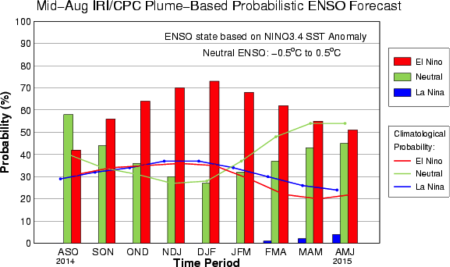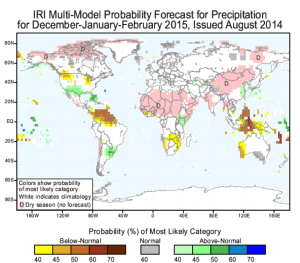August Climate Briefing: To Be or Not To Be?
From the August climate briefing, given by IRI’s Chief Forecaster Tony Barnston:
Tony Barnston provides an overview of the briefing
Changes from last month’s briefing
Based on the latest models, the chance of an El Niño developing during the August-October season is 40%, down from 60% last month. The probability for El Niño development by the late months of 2014, however, remains at 70-75%, similar to IRI’s July forecast. This El Niño forecast for late 2014 is up slightly from the NOAA Climate Prediction Center/IRI forecast issued on August 7. Barnston said models now have more certainty than a few months ago, and that a weak El Niño is the most likely scenario, with a moderate event the next most likely.

The IRI/CPC probabilistic ENSO forecast issued mid-August 2014. Note that bars indicate likelihood of El Niño occurring, not its potential strength. Unlike the official ENSO forecast issued at the beginning of each month, IRI and CPC issue this updated forecast based solely on model outputs. The official forecast, available at http://1.usa.gov/1j9gA8b, incorporates human judgement.
Chance for a more immediate development of El Niño has fallen due to the cooling of sea-surface temperatures in the central Pacific Ocean. Although the western and eastern Pacific continue to see above average sea-surface temperatures, the central part of the basin has hovered around average over the past few weeks.
The Struggle to Couple
If sea-surface temperatures are cooler, why is the long-range forecast for El Niño still above 70%? The El Niño-Southern Oscillation, or ENSO, is a coupled system. This means that in order for an El Niño event to be fully established, the ocean and atmosphere must respond to each other in a positive feedback cycle. Earlier this summer, the ocean looked ripe for El Niño development, but the necessary atmospheric conditions never kicked in.
“Right now, however, the atmosphere is beginning to show signs of the onset of El Niño, while the ocean is less suggestive,” said Barnston. “We think coupling of ocean and atmosphere is more likely now, though, because the Intertropical Convergence Zone, a band of enhanced convection…will be over the equator in the next month or two.”
If the central Pacific Ocean gets just a little bit warmer, it will be more likely to couple with the atmosphere than it was a few months ago. So, even though current observations do not suggest El Niño conditions, it may not take much for conditions to change.
Such late development of El Niño is not unheard of; Barnston recalled the 1986 El Niño, which formed in September of that year. He said it is possible this one could form even a little later, potentially in October. There is also a chance that El Niño conditions could form for a few months–meaning temperatures in the central Pacific stay at least 0.5ºC above average–but that an official El Niño episode may not be declared, as this requires five overlapping three-month periods of such conditions.
Effects of El Niño on global seasonal forecasts
 Each month, IRI issues seasonal climate forecasts for the entire globe. These forecasts take into account the latest ENSO projections and indicate which areas are more likely to see above or below normal temperatures and rainfall.
Each month, IRI issues seasonal climate forecasts for the entire globe. These forecasts take into account the latest ENSO projections and indicate which areas are more likely to see above or below normal temperatures and rainfall.
Although an El Niño has yet to develop, the climate impacts are still expected to resemble those of a weak to moderate El Niño. For the December-February period, when the potential El Niño is predicted to be at its strongest, the forecast continues to show a strong likelihood of drier than normal conditions over Indonesia and a moderate likelihood of drier conditions in Central America (image right). Wetter-than-average conditions are still expected over southeastern South America later this year.
Scientists should know more each month about the chances for El Niño, its potential strength, and the climate impacts. Sign up here to get notified when the next forecast is issued, and in the meantime, check out #IRIforecast or use #ENSOQandA on Twitter to ask your El Niño questions.

You must be logged in to post a comment.